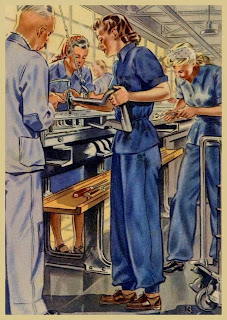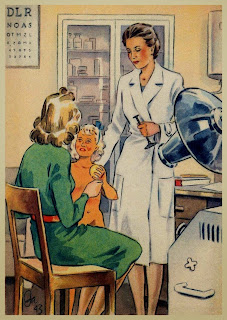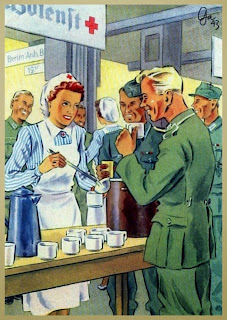According to Penny Colman one of the most dramatic
changes during World War II was the number of women who went to work. As the
armed forces filled its ranks with manpower, industry filled its jobs
with womanpower.
Because of the
absence of many men who either joined the military or took jobs in war
production industries, some women moved outside their traditional roles and
took positions in jobs usually reserved for men.
Germany was
ruled by the same conditions. By 1945, German women were holding 85% of the
billets as clericals, accountants, interpreters, laboratory workers, and
administrative workers, together with half of the clerical and junior
administrative posts in high-level field headquarters.
Like other
country's there was propaganda who focused on the female worker. Erich Gutjahr
Bildverlag at Berlin was a publisher who issued 20 postcards with drawings of three
different painters: Hahmeyer, Becker and Gagelmann. The serie was titled 'Frauen
schaffen für euch" (Women working for you).
Hahmeyer
Not much is known of Eva Hahmeyer. She was an illustrator of various books. In this case the subject was a postcard of a NSV-woman.
The
Nationalsozialistische Volkswohlfahrt (NSV), meaning "National Socialist
People's Welfare" was a social welfare organization during the Third
Reich. The NSV
became established as the single Nazi Party welfare organ in May 1933. One of
the special fields was "Mother and
child".
|
|
Becker
It is almost certain that Becker came from a famous artist family. But that is all.
Picture no. 667 shows a DRK-woman. DRK means Das Deutsche Rote Kreuz (Red Cross). Following Hitler's takeover of the government in Germany in January
1933, the NSDAP (Nazi Party)
moved to control the Red Cross. Thus the DRK became a legally recognized
organization of the NSDAP in December 1937. Finally, at the end of 1938 the
German Red Cross officially came under the control of the Ministry of the
Interior's Social Welfare Organization, becoming de facto a Nazi entity.
|
|
|
|
|
|
|
|
Gagelmann
Gert Gagelmann was known for his illustrations for fashion-magazines. But with proud breasts and high heels Gagelmann pushed the woman a little bit further than only fashionable.
Update: February 2016
Till now
I was not aware of the existence of a considerable, unsigned, collection off erotic drawings contributed to "Julie
Delcourt" or "German". Warning: the link provided contains explicit
sexual content:
There is
discussion whether Gagelmann could be the unknown artist of these unsigned
drawings. In my opinion the postcards and the drawings show indeed an astonishing
similarity. In my 2014 blogpost I made the observation that Gagelmann pushed some women a little bit further than only
fashionable. That meant that Gagelmann in my opinion was well aware of the sexual
component which could be added to a, ad first glance, ordinary scene. If it
turns out that Gagelmann is indeed the unknown artist I can not say that I
would be surprised.
|
|
|
|
|
|
|
|
|
|



































10 reacties:
Hello,
thanks to your work, I managed to discover that a mysterious erotic artist called badly "Julie Delcourt" is Gert Gaglemann.
Somehow I have the impression that Julie Delcourt is an altogether separate artist. My guess is that Gagelmann came across the Julie Delcourt drawings (2 that I know of) and copied them, incorporating the setup and poses into his extensive series of enema illustrations that were apparently commissioned by someone after the war. Or else perhaps the person who commissioned Gagelmann wanted further illustrations in this style ...
@A Gracier: you like complicated stories, no? It's obvious here and you need some more mystery. Maybe it was Elvis Presley who asked Picasso to draw like Gaglemann.
@Camille MM
Thanks for your comment. The cards of Gagelmann are, as I mentioned in my blogpost, erotic by nature. The women hide a secret desire. Compared with your examples it is striking how one and an other fit together.
@Camille MM
I don't particularly care for complicated stories, because it becomes more difficult to figure things out.
But on the other hand, declaring Julie Delcourt and Gagelmann to be one and the same artist seems a bit too simple. There is no reason to think that artists didn't copy other works they liked or wished to have a copy of. Remember, these drawings were made in the days before photocopiers. I've also read in various 1930s sexology works published in Germany (before the Nazi takeover obviously) that sharing erotic illustrations, or making them according to the wishes of others, was not an uncommon practice. Think Bernard Montorgueil whose work was also shared and circulated before it was printed in book form.
And there is also the question of style. Gagelmann's work is highly polished and finished as with that of commercial artists. Julie Delcourt's 2 drawings are competent of course, but they do seem to be the work of a gifted amateur.
And then you could also ask: if 2 drawings were signed as Julie Delcourt, why not sign the other 100+ series of enema illustrations with the same name?
I still think Julie Delcourt and Gagelmann being 2 seperate people makes the most sense.
@Gracier: OK, it's not a very intersting discussion. I suggest something based on solid proof, you suggest something else based on your own feelings. I cannot argue against feelings so I end the discussion here.
I wasn't talking about my feelings. Where do you read anything about feelings?
I simply pointed out and explained several reasons that might support what I think to be the case: Delcourt and Gagelmann are 2 separate illustrators. Even just by looking at the two illustrations by Delcourt and Gagelmann of the same scene, there is no denying that the styles are different.
Perhaps a comment from an art historian and an artist is in order here. My undergraduate degree is in art history and I continued on to obtain another one in studio practices in art. After reading the short discussion/argument on Gert Gagelmann, I think I can see that both Camille MM and A Gracier essentially agree when you get right down to it. Gert Gagelmann is most probably the artist of the very fine erotic enema themed watercolours now well known to many. The stylistic affinities between the "Frauen schaffen fur euch" (trans. Women working for you) postcards circa 1943 and the enema series are undeniable. Any working artist fluent in watercolour practices will tell you as much. There is no reason, in my opinion, to believe that Julia Delcourt was anything other than someone who opportunistically chose to make artistically inferior copies of a couple of the Gagelmann watercolours and then simply sign her name to them. I hope this clears things up.
I’m quite sure that the “Julie Delcourt” drawings are inferior copies made with the intention of creating confusion.
I'm certain the 'Julie Delcourt' drawings are copies. However I doubt they were made to create confusion. What would be the point and who would they be meant to confuse?
The JC drawings are probably just copies made back when photocopying was not available and when people did wish to have copies of drawings they particularly admired or liked.
Post a Comment